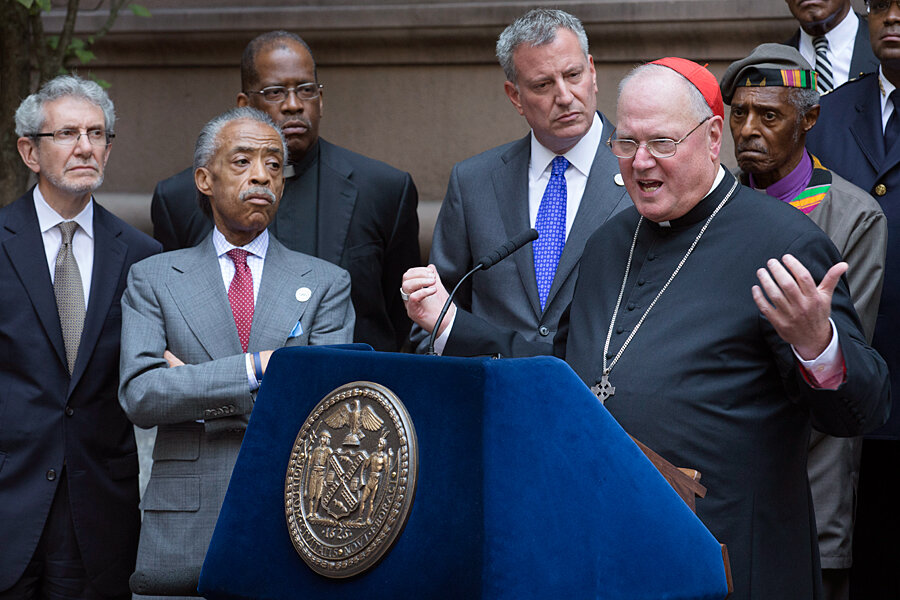Ahead of march for chokehold victim, New York leaders and clergy come together
Loading...
| New York
New York Mayor Bill de Blasio and police Commissioner William Bratton discussed the city’s simmering unrest with members of New York’s clergy Wednesday, seeking to find ways to move the city forward as it continues to grapple with last month’s killing of Eric Garner allegedly at the hands of police.
The interfaith meeting, held at the residence of Cardinal Timothy Dolan, the Catholic archbishop of New York, came just three days before a major protest march and rally are scheduled to take place in Staten Island, where Mr. Garner died after an apparent chokehold. The protest is being organized by the Rev. Al Sharpton, who also attended the round table.
Noting there was “a seriousness, an urgency, and an extraordinary unity” at the meeting, Mayor de Blasio and Commissioner Bratton sought the help of the city’s ministers, which included leaders of Jewish, Christian, and Muslim communities, to ease the tensions in minority neighborhoods, which have bristled for years under the aggressive street tactics of the New York Police Department.
“This group has convened for a purpose – an ongoing purpose: This group of leaders will help us perfect our approach to deepening our reforms and bringing them to each and every neighborhood, and making the communities true partners with police,” the mayor said near the steps of St. Patrick’s Cathedral. “These leaders will help us send a message of peace and reconciliation all over this city, and it will happen on an ongoing basis until greater progress is secure.”
Though de Blasio scheduled this round table a day before the police shooting of Mike Brown, an unarmed teen in Ferguson, Mo., the rage and violence expressed in the St. Louis suburb has underscored the tensions on New York streets. The large Staten Island protest was also planned before the shooting.
“We do not tolerate violence at marches,” said Mr. Sharpton at the press conference following Wednesday’s meeting. “I have no fear of that at all on Saturday, and if it ever were to occur, we would stop it and would not tolerate it. There is a difference between thugs and activists. We're activists. We're not thugs. And we will not harbor thugs.”
Sharpton’s National Action Network is the major sponsor of Saturday’s march and rally.
The mayor’s turn to the city’s clergy, many say, is something of a shift for the administration. De Blasio does not identify with any organized religion, and he does not attend services. Many of the rank and file of the NYPD took it personally when the mayor refused to march in the city’s annual St. Patrick’s Day parade, which remains important for many in the department, given its longstanding Irish Catholic heritage. De Blasio had criticized the parade, whose organizers refuse to allow an official gay and lesbian presence.
But the clergy round table, hosted by Cardinal Dolan, resonated with members of the NYPD – even though most of them continue to resent de Blasio, after his scathing critiques of the department as a mayoral candidate last summer.
“But I give the mayor kudos for reaching out to the cardinal right now, because he might be the only guy right now with credibility,” says Ed Mullins, president of the Sergeants Benevolent Association, in a Monitor interview last week. He is a frequent critic of de Blasio, and a vehement critic of Sharpton.
“Trying to solve the divide that’s in the works right now, I just think it’s going to have to take some time, credible people, and then we can build bridges,” Mr. Mullins says. “In that respect, it’s a good step: I think the mayor’s making the right choice by doing that.”
Since becoming mayor, de Blasio has quelled his criticism of police, and he has steadfastly supported his police force throughout the Garner crisis – to the chagrin of many of his progressive supporters.
Religious leaders did not mention Bratton’s “broken windows” policing theories, which include aggressive enforcement of low-level crimes in high-crime neighborhoods – and which critics say led to the fatal arrest of Garner, who resisted police, and who made a living in part by selling loose cigarettes. Minority leaders say these tactics unfairly target men of color and amount to relentless harassment in their neighborhoods.
Bratton credited the mayor with his riff on the old police adage, “to protect and serve,” which de Blasio revised to “to protect and to respect.” “The role of police is not just to serve, but the role of the police is to build relationships,” Bratton said Wednesday, echoing de Blasio’s frequent theme.
“But it also resonates with me because it has a duality,” the commissioner continued. “It has a duality in that it means that to protect, and to respect, is not just the obligation of the police, but of the community – the idea that we have to have a mutual respect for the law. The police – that when we enforce it, we do it lawfully, respectfully, consistently. And the public have a respect for the law that they obey it.”
At the press conference Wednesday, De Blasio infused his usual themes with a language somewhat unusual for the secular progressive.
“The notions of redemption that run through so many faiths are all about letting people air their concerns, their grievances, their imperfections,” the mayor said. “But government has to do that, and government has often failed to do that. And the very act of active and compassionate listening actually changes people. It changes whether people feel they can find a democratic and peaceful solution, or whether they feel it's unavailable to them.”








